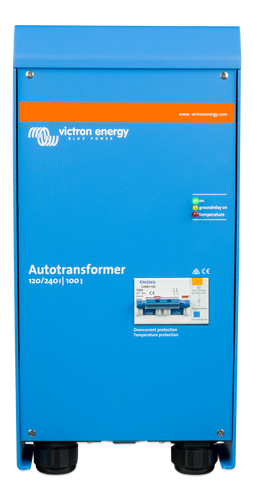Stock:
Small amount
Product number:
ITR000100101
EAN:
8719076022428
Google Reviews
The Spartransformer: For the compensation of upward, tensioning and splitting phases
A savings transformer can be used to compensate for upward, tensioning and gap phase outputs. While the upward and crooking functions are quite simple, the compensation of the split phase output requires a little more attention.
As an example, we take a split phase supply of 30 A 120/240 V.
The supply can take place via the network, a generator or two linked inverters.
Some of the connected loads require 240 V, other 120 V. The load 30 A should not exceed on each 120 V cycle. It is problematic that the two cycles have different electricity as soon as 120 V loads are connected. The reason for this is that the 120 V loads on the two cycles will never be balanced. A 120 V hair dryer with 1200 W, for example, pulls 10 A of a circulation. A 120 V washing machine can even pull more than 20 A of a circulation. The electricity difference between the two cycles, also called electricity unmetry, is therefore often 20 A or more. This means that the 30 A supply is not fully exploited. As soon as a cycle 30 A pulls, the other cycle may not pull more than 10 A. An increase in the 240 V load, for example, then leads to an overload of the one circulation, while the other circulation still has free capacity.
In theory, the total power of a power supply with 30 A and 120/240 V = 30 x 240 = 7.2 kVA is.
In the case of an unimmetry of 20 A, the practical maximum is 30 x 120 + 10 x120 = 4.8 kva or 67 % of the theoretical maximum.
The solution is a savings transformer.
If you leave the neutral manager of the split phase supply unused and connect a savings transformer as a new zero -conductor, as shown in Figure 1, every unimmetry of the load is "absorbed" by the Spartransformer.
In the event of a 30 A supply, the load can be increased to 7.2 KVA. A 20 A-UNSYMMETRE The load leads to the fact that one circulation 40 a and the other 20 A delivers. The difference of 20 A flows through the zero conductor and the coil of the Spartransformer. The electricity due to the two 120 V lines of the split phase supply is 30 A.
Including ground relay for use with Multi or Quattro interverters/chargers
When operating in the inverter mode, the zero manager of the inverter/charger must be connected to the ground to ensure the proper functioning of a GFCI. In the event of a split phase supply, the zero conductor must be grounded. For this purpose, an ground relay is installed in the housing of the Spartransformer. The relay is controlled by the 230/240V Multi or Quattro. (The internal ground relay of the 230/240 V Multi or Quattro must be deactivated)
Temperature -protected
In the event of overheating, the savings transformer is separated from the power supply. The reset is manually.
An alternative to coupled inverters
The alternative to the coupling of two 120 V interverters for a 120/240 V-split phase supply is a 240 V-inverter with an additional saving transformer.
Two stacked 120 V inverters with 3 KVA deliver up to 25 A to every 120 V cycle. If the load is less than 25 A on a cycle, the maximum load on the other cycle is still limited to 25 A.
A 240 V inverter with 5 KVA and a 32 A-saving transformer supplies each 120 V circuit with a balanced load of up to 21 A. However, fewer loads on a circulation lead to the fact that more power is available on the other cycle, however The maximum wirmmetry is 32 A.
The load can therefore be up to 38.5 A on a circulation if the load on the other cycle is no more than 3.5 A (maximum wiring: 38.5 / 3.5 / 35 a if with an asymmetrical load too is therefore a 240 V inverter with a lower power and saving transformer of the solution with coupled inverters.
A savings transformer can be used to compensate for upward, tensioning and gap phase outputs. While the upward and crooking functions are quite simple, the compensation of the split phase output requires a little more attention.
As an example, we take a split phase supply of 30 A 120/240 V.
The supply can take place via the network, a generator or two linked inverters.
Some of the connected loads require 240 V, other 120 V. The load 30 A should not exceed on each 120 V cycle. It is problematic that the two cycles have different electricity as soon as 120 V loads are connected. The reason for this is that the 120 V loads on the two cycles will never be balanced. A 120 V hair dryer with 1200 W, for example, pulls 10 A of a circulation. A 120 V washing machine can even pull more than 20 A of a circulation. The electricity difference between the two cycles, also called electricity unmetry, is therefore often 20 A or more. This means that the 30 A supply is not fully exploited. As soon as a cycle 30 A pulls, the other cycle may not pull more than 10 A. An increase in the 240 V load, for example, then leads to an overload of the one circulation, while the other circulation still has free capacity.
In theory, the total power of a power supply with 30 A and 120/240 V = 30 x 240 = 7.2 kVA is.
In the case of an unimmetry of 20 A, the practical maximum is 30 x 120 + 10 x120 = 4.8 kva or 67 % of the theoretical maximum.
The solution is a savings transformer.
If you leave the neutral manager of the split phase supply unused and connect a savings transformer as a new zero -conductor, as shown in Figure 1, every unimmetry of the load is "absorbed" by the Spartransformer.
In the event of a 30 A supply, the load can be increased to 7.2 KVA. A 20 A-UNSYMMETRE The load leads to the fact that one circulation 40 a and the other 20 A delivers. The difference of 20 A flows through the zero conductor and the coil of the Spartransformer. The electricity due to the two 120 V lines of the split phase supply is 30 A.
Including ground relay for use with Multi or Quattro interverters/chargers
When operating in the inverter mode, the zero manager of the inverter/charger must be connected to the ground to ensure the proper functioning of a GFCI. In the event of a split phase supply, the zero conductor must be grounded. For this purpose, an ground relay is installed in the housing of the Spartransformer. The relay is controlled by the 230/240V Multi or Quattro. (The internal ground relay of the 230/240 V Multi or Quattro must be deactivated)
Temperature -protected
In the event of overheating, the savings transformer is separated from the power supply. The reset is manually.
An alternative to coupled inverters
The alternative to the coupling of two 120 V interverters for a 120/240 V-split phase supply is a 240 V-inverter with an additional saving transformer.
Two stacked 120 V inverters with 3 KVA deliver up to 25 A to every 120 V cycle. If the load is less than 25 A on a cycle, the maximum load on the other cycle is still limited to 25 A.
A 240 V inverter with 5 KVA and a 32 A-saving transformer supplies each 120 V circuit with a balanced load of up to 21 A. However, fewer loads on a circulation lead to the fact that more power is available on the other cycle, however The maximum wirmmetry is 32 A.
The load can therefore be up to 38.5 A on a circulation if the load on the other cycle is no more than 3.5 A (maximum wiring: 38.5 / 3.5 / 35 a if with an asymmetrical load too is therefore a 240 V inverter with a lower power and saving transformer of the solution with coupled inverters.
Login



